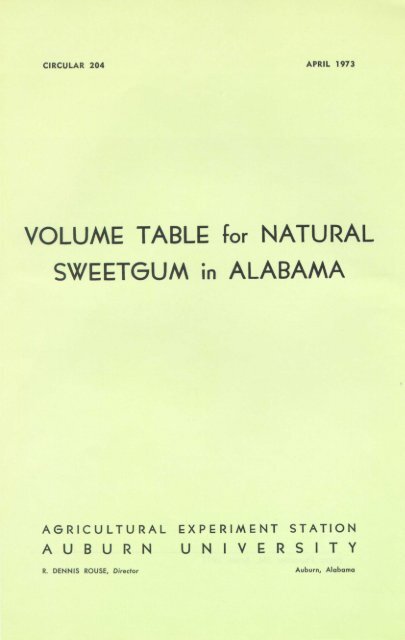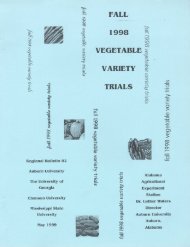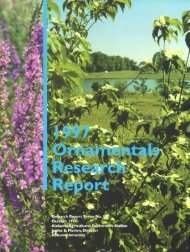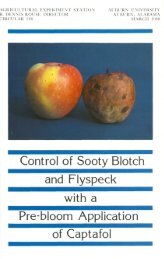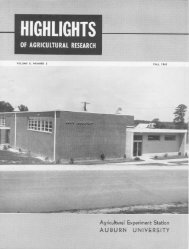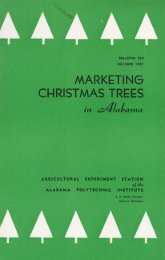VOLUME TABLE for NATURAL SWEETGUM in ALABAMA - Auburn ...
VOLUME TABLE for NATURAL SWEETGUM in ALABAMA - Auburn ...
VOLUME TABLE for NATURAL SWEETGUM in ALABAMA - Auburn ...
Create successful ePaper yourself
Turn your PDF publications into a flip-book with our unique Google optimized e-Paper software.
CIRCULAR 204<br />
ARL17<br />
APRIL 1973<br />
<strong>VOLUME</strong> <strong>TABLE</strong> <strong>for</strong> <strong>NATURAL</strong><br />
<strong>SWEETGUM</strong> <strong>in</strong> <strong>ALABAMA</strong><br />
AGRICU LTU RAL<br />
A UB UR N<br />
R. DENNIS ROUSE, DirectorAuunAabm<br />
EXPE RIME NT STATION<br />
U N I V E R S I T<br />
<strong>Auburn</strong>, Alabama
FIRST PRINTING 3M, APRIL 1973
Volume Table <strong>for</strong> Natural<br />
Sweetgum <strong>in</strong> Alabama<br />
E. S. LYLE, JR.<br />
THERE HAS BEEN an <strong>in</strong>creased <strong>in</strong>terest <strong>in</strong> the growth and management<br />
of all Southern hardwoods <strong>in</strong> the past few years. Sweetgum<br />
(Liquidambar styraciflua L.), which is one of the more important<br />
of these hardwoods, <strong>for</strong>ms pure stands that are amenable<br />
to growth studies. Accord<strong>in</strong>g to the U.S. Forest Service there<br />
are approximately 900 million cubic feet of sweetgum <strong>in</strong> Alabama,<br />
which exceeds the volume of any other hardwood species. Consequently,<br />
it seems worthwhile to have a volume table <strong>for</strong> sweetgum<br />
based solely on data from natural stands <strong>in</strong> Alabama.<br />
Field Data Collection<br />
Fifty stands of natural sweetgum were located with<strong>in</strong> the State<br />
by extensive exploration dur<strong>in</strong>g 1971 and 1972. The figure shows<br />
the approximate location of each stand. All of these stands had<br />
closed canopies, were even-aged, and ranged <strong>in</strong> age from 6 to<br />
50 years. Stand basal area ranged from 25 sq. ft. to 200 sq. ft.<br />
At least 80 per cent of the trees <strong>in</strong> each stand were sweetgum.<br />
Topographic positions ranged from bottoms to hillsides. Approximately<br />
45 of the stands could be identified as hav<strong>in</strong>g orig<strong>in</strong>ated<br />
on old fields, and the others may have been of similar orig<strong>in</strong>.<br />
Stands <strong>in</strong> which more than 20 per cent of the trees had multiple<br />
stems or top die-back were excluded from this study.<br />
At each stand, the first two dom<strong>in</strong>ants encountered with<strong>in</strong> the<br />
stand were selected as sample trees and felled. Diameter measurements<br />
both <strong>in</strong>side and outside bark were made at 4-foot <strong>in</strong>tervals<br />
beg<strong>in</strong>n<strong>in</strong>g at the top of a 6-<strong>in</strong>ch stump. Other measure-<br />
Assistant Professor, Department of Forestry.<br />
[3]
LOCATION OF <strong>SWEETGUM</strong> STANDS IN <strong>ALABAMA</strong>.<br />
ments taken were diameter at breast height and total tree height.<br />
Diameters at breast height ranged from 1.4 to 13.9 <strong>in</strong>ches and<br />
total tree heights from 13.9 to 99.9 feet.<br />
[41]
Volume Equation Development<br />
Smalian's <strong>for</strong>mula was used to calculate the volume of each<br />
4-foot bolt, and the volume of the tip of the tree was obta<strong>in</strong>ed<br />
by treat<strong>in</strong>g it as a cone. 2 Total volumes <strong>for</strong> both <strong>in</strong>side and outside<br />
bark were calculated from this data <strong>for</strong> each tree.<br />
Regression equations were developed that described the relationship<br />
between tree volume and a function of d.b.h. or of d.b.h.<br />
and total tree height. These equations were fitted to the data<br />
by least squares. Table 1 shows the equations that were exam<strong>in</strong>ed<br />
and some statistics of fit.<br />
All equations exam<strong>in</strong>ed accounted <strong>for</strong> at least 84 per cent of the<br />
variation <strong>in</strong> cubic foot volume. The addition of a height variable to<br />
equations conta<strong>in</strong><strong>in</strong>g either d.b.h. or (d.b.h.)2 was not significant.<br />
The <strong>in</strong>teraction variable, (d.b.h.)2 .x height, was the s<strong>in</strong>gle most<br />
potent variable. However, the addition of (d.b.h.) 2 was significant<br />
even after fitt<strong>in</strong>g the <strong>in</strong>teraction variable. Plots of the <strong>in</strong>dependent<br />
variable (d.b.h. ) 2 x height on volume <strong>in</strong>dicated that volume<br />
variances were homogeneous about the regression l<strong>in</strong>e. There<strong>for</strong>e,<br />
weight<strong>in</strong>g to account <strong>for</strong> non-homogeneous variances, common<br />
<strong>in</strong> most volume equations, was not necessary.<br />
<strong>TABLE</strong> 1. <strong>VOLUME</strong> EQUATIONS EXAMINED AND STATISTICS OF FIT<br />
Equa-<br />
Equationx<br />
tion<br />
No. Y bo b X b R<br />
A<br />
2<br />
Sy. x<br />
1 Vob -12.823975 +3.098044 D -0.860 3.2181<br />
2 Vib -11.190348 +2.642770 D -0.846 2.8984<br />
3 Vob - 2.95676049 +0.21221190 D2 - 0.949 1.9433<br />
4 Vib - 2.81563178 +0.18165156 D 0.940 1.8053<br />
5 Vob - 0.023726642 +0.00227509 DH 0.991 0.8280<br />
6 Vib - 0.33246026 +0.00195291 D2H 0.987 0.8329<br />
7 Vob 0.55610109 +0.00265356 D 2 H -0.03665529 I 0.992 0.7909<br />
8 Vib 0.419120932 +0.00244348 IDH -0.04751313 I 0.989 0.7670<br />
9 Vob +0.00227205 D 2 H 0.997 0.8239<br />
10 Vib +0.00228576 IDH -0.03039457 1)2 0.996 0.7776<br />
'Where: Vob = volume outside bark <strong>in</strong> cu. ft.<br />
Vib = volume <strong>in</strong>side bark <strong>in</strong> cu. ft.<br />
D = d.b.h. outside bark <strong>in</strong> <strong>in</strong>ches.<br />
H = total tree height (exclud<strong>in</strong>g 0.5 ft. stump) <strong>in</strong> ft.<br />
2 Coefficient not significantly different from 0.0 at a = 0.05.<br />
2 The computer program <strong>for</strong> this procedure was developed by J. W. Good<strong>in</strong>g,<br />
Dept. of Forestry, <strong>Auburn</strong> University.<br />
2 Statistical Analysis System by A. J. Barr and J. H. Goodnight, Dept. of Statistics,<br />
North Carol<strong>in</strong>a State University, Raleigh, N.C., May 1971.<br />
[5]
Equations 5 and 8 had y-<strong>in</strong>tercepts which were hot significantly<br />
different from zero at a - 0.05. Consequently, these regressions<br />
were recomputed so that the l<strong>in</strong>e passed through the orig<strong>in</strong>.<br />
These two f<strong>in</strong>al equations (Eq. 9 and 10) were used <strong>for</strong> calculation<br />
of the cubic foot volumes <strong>in</strong> Tables 2 and 3. The predicted<br />
values from equations 9 and 10 yield cubic foot volume estimates<br />
that are plus or m<strong>in</strong>us approximately 1.5 cu. ft. per tree with 95<br />
per cent confidence.<br />
[61
<strong>TABLE</strong> 2. TOTAL CUBIC-FOOT <strong>VOLUME</strong>S (OUTSIDE BARK) FOR <strong>NATURAL</strong> <strong>SWEETGUM</strong> IN <strong>ALABAMA</strong><br />
D.b.h. Total tree height (feet) Di-<br />
(<strong>in</strong>ch- amees)<br />
15 20 25 30 35 40 45 50 55 60 65 70 75 80 85 90 95 100 105 110 ter<br />
dist.<br />
(cubic feet)<br />
2 0.14 0.18 0.23 0.27 0.32 1<br />
3 0.31 0.41 0.51 0.61 0.71 0.82 0.92 5<br />
4 0.73 0.91 1.09 1.27 1.45 1.63 1.82 2.00 5<br />
5 1.42 1.70 1.99 2.27 2.55 2.84 3.12 3.40 3.69 8<br />
6 2.45 2.86 3.27 3.68 4.09 4.49 4.90 5.31 5.72 6.13 10<br />
7 4.45 5.01 5.56 6.12 6.67 7.23 7.79 8.34 8.90 9.45 12<br />
8 7.26 7,99 8.72 9.44 10.17 10.90 11.62 12.35 13.08 12<br />
9 9.19 10.11 11.03 11.95 12.87 13.79 14.71 15.63 16.55 17.47 22<br />
10 12.48 13.62 14.75 15.89 17.02 18.16 19.2920.43 21.56 22.70 12<br />
11 16.48 17.85 19.23 20.60 21.97 23.35 24.72 26.09 27.47 7<br />
12 19.61 21.25 22.88 24.52 26.15 27.78 29.42 31.05 32.69 34.32 3<br />
13 23.02 24.94 26.85 28.77 30.69 32.61 34.53 36.44 38.36 40.28 42.20 0<br />
14 31.14 33.37 35.59 37.82 40.0 42.27 44.49 46.72 48.94 2<br />
15 40.86 43.41 45.97 48.52 51.07 53.63 56.18 0<br />
Height 2 0 1 4 3 3 6 4 8 8 9 12 10 15 7 6 0 2 0 0<br />
'Does not <strong>in</strong>clude a six <strong>in</strong>ch stump.<br />
Block shows extent of observed data.<br />
Confidence limits per tree are ± 1.5 cu. ft. with 95% confidence.
<strong>TABLE</strong> 3. TOTAL CUBIC-FOOT <strong>VOLUME</strong>S (INSIDE BARK) FOR <strong>NATURAL</strong> <strong>SWEETGUM</strong> IN <strong>ALABAMA</strong><br />
D.b.h.<br />
(<strong>in</strong>ches)<br />
15 2025 3035 4045<br />
Total tree height' (feet)<br />
505560 65 7075<br />
(cubic feet)<br />
80 8590 95 100 106<br />
i-<br />
ameil0<br />
ter<br />
dist.<br />
2<br />
3<br />
4<br />
5<br />
6<br />
7<br />
8<br />
9<br />
10<br />
11<br />
12<br />
13<br />
14<br />
15<br />
0.0.<br />
0.174<br />
11 0.15 0.20<br />
S50.02<br />
0.24 0.34 0.45 0.55 2.99 0.65 3.5 4.1 680.03 4.6 5.2<br />
0.143 0.1 0.79 00.98 1.16 1.34 950.25 1.1<br />
5.7 0 6.3 6.9 7.4 8.03<br />
8 9<br />
0.95 1.24 1.53 1.81 2.10 1290.67 2.67 2295<br />
1.79 2.20 3.029 3.43 3..4 S1.37 12.61 4.25 4.608<br />
22.38<br />
6.07.28.5951.4027.4 29.88132 14.36 36.60384410432<br />
34.30 36.88 39.45 42.02 44.59 47.16 49.73<br />
Height 2 0 1 4 3 3 6 4 8 8<br />
9<br />
dist.<br />
12 10 15 7 6 0 2 0 0<br />
'Does not <strong>in</strong>clude a six <strong>in</strong>ch stump.<br />
Block shows extent of observed data.<br />
Confidence limits per tree are ± 1.5 cu. ft. with 95% confidence<br />
1<br />
5<br />
.5<br />
8<br />
10<br />
12<br />
12<br />
22<br />
12<br />
7<br />
3<br />
0<br />
2


